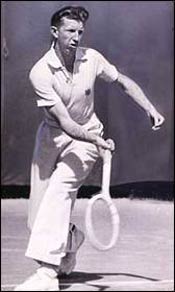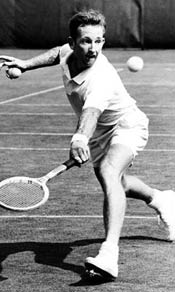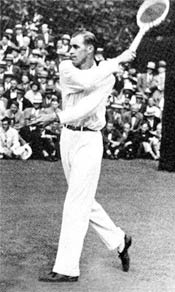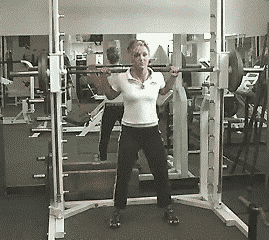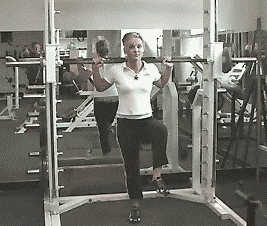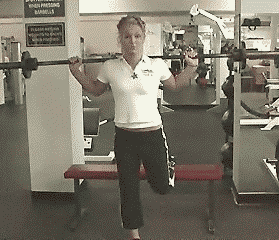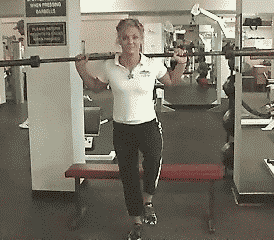|
TennisOne Lessons Is Nadal Sending Out the Wrong Message? Paul Gold With the modern tennis focus on power and the physique of Nadal, players are hitting the gym in the quest to become stronger and more powerful on the court. Increasing strength can improve the intensities at which players can perform (as well as reduce the potential for injury), but can you be too strong?
For example, there have been many past players who were acknowledged as being very fit but I think you would agree not visually brimming with strength and power like Nadal. But would they have been more “talented” if they would have been stronger? Would they have been that much better if they had been training today?
There is no question that strength without skill or even good skill levels with low strength will produce less than optimum results, but does it really matter if a player can squat 200+ kg or is a squat of 100 kg along with great stability, power, body control, and skill etc. a better combination? I can hear some of you saying “why not have all these and a 200+ kg squat”? The main problem I see is that many coaches and fitness trainers are getting their players to weight train using “old” non sports specific bodybuilding principles focusing on building size in isolated muscles using exercises that focus primarily on one plane of motion. Is this the fault of the players like Nadal – is Nadal sending out the wrong message? Let’s get back to that 200+ kg squat. To work on the squat in this way means at best that the player loads up the bar to the point where they need a “spotter” for safety reasons or they use a cage that is safer but because the bar is fixed does not allow them to work in a multi-planer environment – which after all is how the game is played. The big problem with both of these scenarios is that the excessive loading that must occur to the spine and joints on an ongoing basis must impact on the risk/safety ratio over time. The greater the loads we use in this way surely increase the chance of injury and often player, in my experience, get to “failure” because of the physical and mental pressure of the bar on their backs rather than because of fatigue in the legs.
While I completely understand the push for greater loads to improve absolute strength levels, I feel that there is a different way to improve performance and reduce injuries. There is no doubt that for a player to improve strength they must train at intensities high enough to elicit a strength response (principle of overload) but I feel that there is a better way to increase muscular and nervous system loading, yet lessening the strain on the spine and joints. To achieve this, I recommend the use of single leg exercises, which not only produce great strength gains but also increased stability and balance without the risk of back and joint injury. If we think about it, the game is played predominantly on a single leg basis anyway. You can still do maximal lifts just as one would with double leg squatting, without the excessive loads on the spine and joints. You can also use this type of training on the upper body with the use of dumbbells. This again forces a greater nervous system response. I also believe that training in this way improves strength in a way that provides an added skill component to a players’ physical training that will reap rewards as they will transfer directly to the court. Ultimately then it is not Nadal sending out the wrong message but that the message is being wrongly interpreted by much of the coaching and playing community and what is worse is the fact that some wrong information gets further distorted in a kind of Chinese tennis whisper to the point where everyone is completely missing the point.
The point is that Nadal is a very talented player who obviously was born with these great tennis skills which he has honed over the years. The physique he has and the physicality of his game only go to enhance his considerable racquet skills without which he would not be he same player. Don’t misunderstand me; the physical side of his game is very important just as it is to many of the top tour players but to train the nervous system (by adding balance and stabilizing challenges) alongside the muscular system is a superior form of training from both a skill enhancement and functional basis as well as being a safer environment for the players. After all in a multi-skilled sport like tennis the objective is to improve sport performance and reduce injury potential, not build entrants for body-building competitions. So do your strength work wisely, which means as a sportsperson not a bodybuilder (there is a difference), which will not only leave you more time for, but will also enhance skill development. Try these single leg squat exercises (they are ranked in order of difficulty): Supported single leg squat - Stand on one leg whilst holding on to a support that allows you to maintain balance. Keep the weight on your heel; push your hips back whilst keeping the back neutral. Squat as low as you can with good posture.
Bulgarian Split squat -. Place the back leg up on a bench behind the player. Keep the knee over the foot and the weight on the heel whilst lowering down to at least a parallel position and then up again. Single leg box squat - Use a box or bench that allows the player to touch it with their bottom without sitting down completely. Perform a single leg squat (as above) with no support and as soon as the glutes touch the box come back up. All of the above lifts can be performed weighted, but because they are single leg exercise the loads will not be as heavy, although relatively speaking will be equal to double leg weight. The main bonus is that there will be much less strain on the back. Before starting any exercise program, always be sure to first consult your physician.
Paul Gold has a Masters degree in Sports Sciences and is a Performance Enhancement Specialist and Speed Agility Quickness trainer. For information about products and services contact via www.powertennistraining.com |
